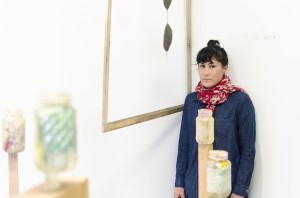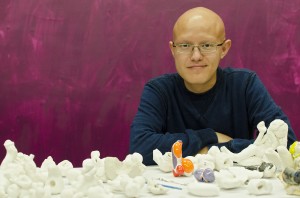Tucked away in the eastern corner of Culver City, the UCLA graduate art studios is a labyrinth, with every turn leading to another graduate student artist’s atelier.
On Saturday evening, the biannual Graduate Open Studios event will open the doors of the student studios to the public to experience art in the space it was created, said Hirsch Perlman, the chair of the art department.
“Each student has their own individual studio, they decide what they want to do,” Perlman said. “Some students will clean up and present a show, some will show things in progress.”
Graduate students generally work individually with three to four faculty members throughout the year, Perlman said. Twice a year, students meet with faculty during reviews which are followed by the Open Studios event.
While the students benefit from the experience of opening their work to the public, Perlman said the public benefits from the exposure to creative activity.
“In a way, Open Studios is a snapshot of the parameters of what some young artists think art is now,” Perlman said.
—
Mitsuko Brooks

(Daniel Alcazar/Daily Bruin)
Painting and Drawing
Mitsuko Brooks’ art puts trash on a pedestal.
The graduate student said she explores the idea of preserving the everyday in her resin sculptures, which are elevated on wooden pedestals arranged throughout her intimate studio – one of 40 student studios in the off-campus graduate art facilities.
A New York City-based artist, Brooks said she found inspiration while working in a library archive to explore using a new medium in a new city. She said she spent over 10 years processing things that could be seen as trash, folding them into archival tissue papers.
“A little note someone wrote in the ’30s would be filed away with a description, and for a researcher who wants to look at it 10 or 20 years later, it’s like a gold mine,” Brooks said.
She said in a similar way, her resin sculptures capture bits of everyday life, often collected from the bottom of her purse. Inspired by the graduate sculpture students at UCLA, Brooks bought small DIY resin kits to explore the medium.
“I don’t think it has the magnitude of information and power that objects catalogued into an archive have, but I’m fascinated by the way objects get outdated, like with cell phones and debit cards,” Brooks said. “What will tampons or movie tickets look like 50 years from now?
She said she thinks these objects say a lot about contemporary society and culture. Her sculptures capture the present like time capsules.
“I guess I’m just really fascinated by trash, things that are discarded and undesirable,” Brooks said.
—
CJ Heyliger
Photography
While he has always been drawn to landscape photography, graduate student CJ Heyliger also saw his work evolve since moving from the East Coast.
“The work I had been making before was very site-specific and heavily researched, like a documentary of a place,” Heyliger said. “Intimate familiarity (to the place) was very important to my practice.”
Now, he said he thinks of the landscape as a studio and less as a subject. Inspired by the iconography of the West and the material of photography, Heyliger said he breaks down photography to the fundamental elements of time and light and explores photographs’ locations in a way where the actual place is insignificant.
“Thinking about how the camera sees and records has led to images that are about the material and mechanical limitations of photography,” Heyliger said.
Through various experimental techniques, he said he is able to make images that are invisible to the human eye, seen by the camera. For one piece, he visited Death Valley on four occasions, tried to orient himself in the exact same place and make the same photograph on the same sheet of film. The result is an overlap of four separate incidents.
“It’s not about location, it’s looking around a landscape and finding raw material that I can use to create something,” Heyliger said.
He said because film photography prevents him from being able to see the image right away, it allows for more experimentation and the loss of control makes for some happy accidents.
For his final Open Studios, Heyliger said he hopes to show both finished work and works in progress.
“It’s exciting for us to have people here,” Heyliger said. “For viewers, I think going to an artist’s studio is exciting because it is frequently not polished. … You get to see things in the process.”
—
Michael Kiyoshi Salvatore

(Daniel Alcazar/Daily Bruin)
Ceramics
Spending the past few years with Teach for America in Houston, Michael Kiyoshi Salvatore has been involved in counseling and mentorship. Fueled by a fascination in people and personalities, the graduate student said his work examines systems people use to understand themselves and others, such as religion, Myers-Briggs and astrology.
“I am bringing together all that I’ve learned into a pseudo-temple religious installation to honor but also play with these different ways of looking at the world,” Salvatore said.
One of his pieces is an autobiographical ceramic work that depicts a moment from his past summer. He said the mock-spiritual experience captured by the work embodies his shift in perspective.
“I found that while knowing about all these systems of bigotry is useful, in the classroom what helped the kids most was simply holding them to virtuous behavior,” Salvatore said. “I realized that there are positive, hopeful ways to build other people and myself up.”
Salvatore said ceramics is relatively new on the art scene as a fine art material. He is drawn to its background in function and hobby, which fosters a friendly, close-knit community.
“It’s one of the first materials humanity used to work from, and being interested in spirituality and religion, I think of how some of the oldest artifacts we’ve found are ceramic,” Salvatore said. “I’m into that romance.”
He said his creative process is carefully planned, drawing inspiration from Renaissance artists. He generally spends about a week, slowly adding precise details as the clay dries.
“With clay, it’s hard to get the surface smooth, pretty much anything you do to it shows,” Salvatore said. “It’s a battle, but I enjoy that labor of love.”
Salvatore said he hopes his show will be playful yet sincere in exploring the aesthetics of myth, religion and ritual.
This event is a chance for him to form a strong connection to his audience, similar to what he sees singers do, but applied to visual arts, Salvatore said.
“Open Studios lets people into a place that looks like art gets made,” Perlman said. “The building in Culver City is that. It feels like a place where art gets made.”
